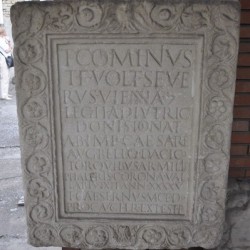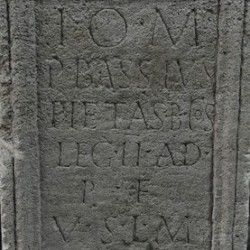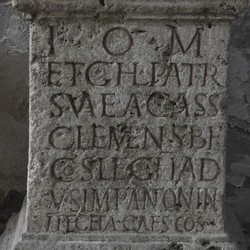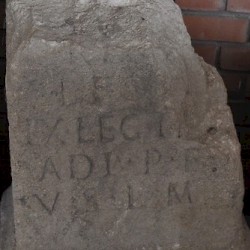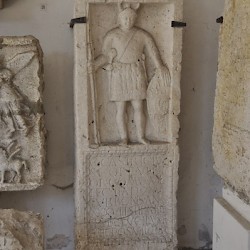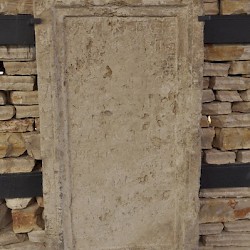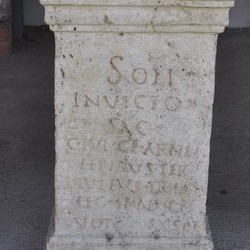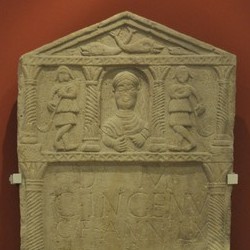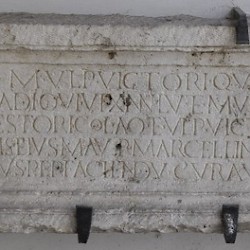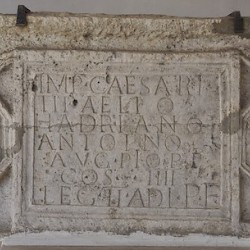Legio II Adiutrix
Legio II Adiutrix: one of the Roman legions. Its name means "helper" or "assistant".
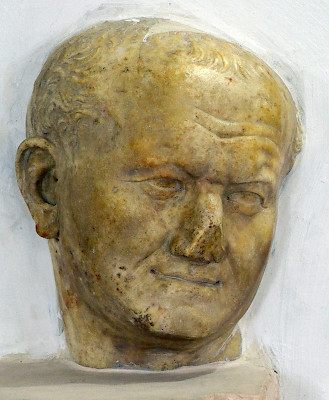
This legion was formed in (early March?) 70 by the emperor Vespasian, who had recently come to power.note Its soldiers were marines from the Ravenna navy, who had sided with Vespasian during his war against the emperor Vitellius. Being conscripted as legionaries was some sort of reward. This origin also explains why the legion was surnamed Pia Fidelis ("loyal and faithful").
The legion saw its first action in the summer of 70, when we find it fighting under Quintus Petillius Cerialis, who was sent out to suppress the Batavian revolt. Together with VI Victrix, XIV Gemina, and XXI Rapax, it defeated the rebel leader Julius Civilis near Xanten. During the winter, the second legion stayed at the Batavian capital Nijmegen. Next year, it was replaced by X Gemina.
Together with general Cerialis, II Adiutrix went to Britain, where it had to reduce the rebellion of the Brigantes under Venutius. Inscriptions prove that the legion was stationed at Deva (Chester) and Lindum (Lincoln), but we cannot establish which town served as the unit's first and second base, although it is usually assumed that the legion's oldest home was Lincoln.
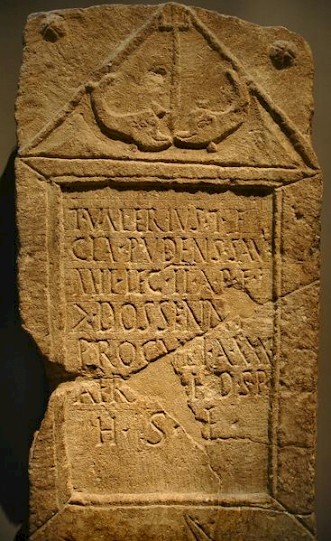
When Gnaeus Julius Agricola was governor of Britain (77-83), the Second was probably moved to Chester, at the mouth of the river Dee on the northern Welsh border. The legion fought against the tribe of the Ordovices and occupied the Isle of Mona (modern Anglesey). During the next years, Agricola tried to subdue Scotland and II Adiutrix seems to have served as strategic reserve in Wales and England.
After Agricola was recalled, the legion was briefly at Inchtuthil, but in 87, it was transferred to the lower Danube, where it was to take part in the wars against the Dacians of the emperor Domitian. Its base may have been at Acumincum near the confluence of the Tisza and the Danube (40 kilometers north of Belgrade). An alternative location of its base is at Sirmium (Sremska Mitrovica).
The Dacians had invaded the Roman empire in 86 and defeated the legions that were supposed to defend the province of Moesia. In 88, a large Roman army group invaded Dacia and general Tettius defeated its king Decebalus at Tapae; the Second was one of nine legions involved. Unfortunately, the revolt of the governor of Germania Superior, Lucius Antonius Saturninus, in 89, prevented the ultimate success.
One of the officers in those days was Publius Aelius Hadrianus, the future emperor Hadrian. He is known as a military tribune in the year 94/95. During his stay with the legion, he met the centurion Quintus Marcius Turbo, who was later to be governor of Pannonia (117-118) and became Hadrian's praetorian prefect.
During Trajan's Dacian wars (101-106), II Adiutrix and IIII Flavia Felix were based at Singidunum (modern Belgrade), but when the war was over, the Second was transferred to Aquincum (Budapest). The new legionary base was built on the site of an older cavalry fort. Here, the Second Legion was to stay for centuries. It can be shown that many soldiers were recruited locally.
They were often employed in civil jobs in the province of Pannonia Inferior. For example, during the reign of Hadrian, a public building was constructed at Mursa (Osijek), and under Caracalla or Heliogabalus, legionaries built the road between Budapest and Belgrade. Other soldiers served the governor as scribes.
The Second was involved in several wars on the east bank of the Danube at the beginning and end of Hadrian's reign. The above-mentioned Quintus Marcius Turbo successfully led II Adiutrix against the Sarmatians in 118, a tribe in eastern Hungary that had annihilated the Twenty-first legion Rapax in 92. In 137, Hadrian's crown prince Aelius Caesar was active in Pannonia as well. He died before much had been achieved, but during the reign of Antoninus Pius (r.138-161), the area was quiet and a subunit of the second legion could be sent to Mauretania to fight against the Moors.
Under the emperor Lucius Verus, II Adiutrix fought against the Parthian empire (162-166), which is more or less the equivalent of Mesopotamia and Iran. During its absence, a subunit of IIII Flavia Felix seems to have guarded Budapest. The commander of the Second was Antistius Adventus.
Between 171 and 173, the Second was active in the northern wars of Marcus Aurelius. In those years, it was temporarily stationed at Trencín in Slovakia, hundred kilometers beyond the Danube on the banks of the river Váh. The losses during this conflict were immense and soldiers that had once belonged to the African third legion Augusta were transferred to the Second.
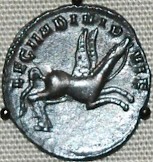
During the civil war of 193, II Adiutrix supported the governor of Pannonia Superior, Lucius Septimius Severus, took part in his march on Rome, and probably in his campaign against his rival Pescennius Niger as well. If so, the soldiers from Hungary were again in Syria and Mesopotamia, where Severus defeated the Parthians.
The presence of (subunits of) the Second during the campaign against the Alamanni in 213 and Caracalla's Parthian war of 214-217 is certain, but after this, we have less information on the regiment's history. In the third century, the legionaries erected statues to the emperors Gordian III and Claudius II Gothicus, which suggests that these rulers did something for the legion. It is extremely likely that Gordian used II Adiutrix when he waged war against the Sasanian empire (238) and that Claudius II used the soldiers during his campaign against the Visigoths (269). A subunit seems to have been at Mainz during the reign of Constantius I Chlorus (293-306).
Its symbols were the Capricorn and the winged horse Pegasus.
Literature
- M. Hassall, "Pre-Hadrianic Legionary Dispositions in Britain", in: Richard J Brewer (ed.), Roman Fortresses and their Legions. Papers in honour of George C Boon (2000)
- M. Hassall, "Legionary fortresses in Britain", in: Yann Le Bohec, Les légions de Rome sous le Haut-Empire (2000 Lyon) 441-457
- B. Lörincz, "Legio II Adiutrix", in: Yann Le Bohec, Les légions de Rome sous le Haut-Empire (2000 Lyon) 159-168
- I. Piso, "Les légions dans la province de Dacie", in: Yann Le Bohec, Les légions de Rome sous le Haut-Empire (2000 Lyon) 205-225
- S. Yanir, "Enlistment in the Legio II Adiutrix at the time of Hadrian and thereafter", in: Scripta Classica Israelica 7 (1983-1984), 58-67
